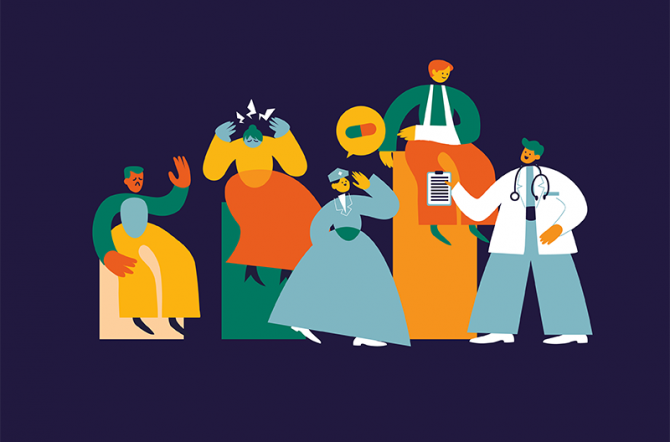In the constantly changing field of medical communication, surgery animation videos have become more important than ever. These animations provide a dynamic visual platform to explain sophisticated surgical procedures that traditional textbooks and written explanations cannot do.
Nevertheless, there’s a need to carefully navigate the fine line between delivering educational content and ensuring viewer comfort. This article explores the intricacies involved in creating thoughtful surgery animations, emphasizing the significance of this distinctive approach to medical communication.
- What is a surgery animation video?
- How to create a surgery animation without disturbing viewers
- 1. Understand the audience
- 2. Research and collaboration
- 3. Process of making a surgery animation video
- 3.1 Choose the narrative and visual approach
- 3.2 Choose mindful animation techniques
- 3.3 Create a Script and Storyboard
- 3.4 Choose between 2D animation and 3D animation
- 3.5 Choose the Right Software for Creating Surgery Animation
- 3.6 Add sound and music to the surgery animation video
- 3.7 Testing and feedback
- Case Study from F.Learning Studio
What is a surgery animation video?
A surgery animation video is like a moving picture that uses special graphics or computer-generated images to show how a surgery works. It’s not just any video; it’s made to give a dynamic and detailed view of how surgeries happen. These videos are handy for teaching doctors, students, or anyone interested in understanding surgeries better.

In these animations, you can see detailed pictures of body parts, learn specific surgical methods, and follow the entire procedure step by step. They’re not just for teaching – these videos help patients understand what’s happening to them, and they’re a way for doctors to share information and learn from each other. The cool part is that these videos are made to be both educational and not too intense, so viewers feel comfortable watching them.
Surgery animation videos are really important in medicine and healthcare for a few reasons:
- Teaching Tool: These videos are great for teaching medical stuff. They show complicated surgeries in a clear and dynamic way. This helps students, residents, and healthcare workers understand the body parts involved, the steps in the surgery, and the techniques used.
- Helping Patients Learn: For people about to have surgery, these videos give a simple overview of what’s going to happen. They show the procedure visually, making it easier for patients to know what to expect, understand the risks and benefits, and make informed decisions. This can also help lower anxiety.
- Communication Between Medical Teams: Surgeons and other healthcare professionals use these videos to talk and plan together. It helps everyone in the team understand surgery better, leading to better teamwork and care for the patient.
- Research and Inventing New Things: These videos are useful for trying out and improving new surgical techniques, devices, or procedures. They let researchers see and refine their ideas before trying them out in a real medical setting.
- Advertising and Public Understanding: Sometimes, these videos are used to promote medical services or tell the public about certain health issues. They present information in a way that’s easy to understand and can reach a lot of people, helping with awareness and understanding.
- Legal and Ethical Stuff: In legal situations related to medicine, these videos might be used to explain surgery to lawyers or judges. This makes sure that everyone gets the facts right about what happened during the procedure.
Recommended reading: Medical Animation: A Complete Guide with 10 Examples in 2024
How to create a surgery animation without disturbing viewers
1. Understand the audience
To begin making a non-disturbing animated surgery video, it’s not just about figuring out who will watch it. You also need to really get what the audience feels and knows. This means understanding their emotions and what they want to learn, making sure the animation works for people with different backgrounds and levels of medical knowledge.
It’s also super important to work closely with doctors and other medical experts. This makes sure the animation is accurate and real, adding trustworthiness to the content.
2. Research and collaboration
Getting the facts right is crucial. Animators need to dig into medical books, look at important studies, and keep up with the newest discoveries. Working closely with healthcare experts is also super helpful. They share valuable insights and help animators really understand the surgeries they’re showing.

3. Process of making a surgery animation video
3.1 Choose the narrative and visual approach
When we talk about crafting a clear and educational narrative, it’s about breaking down the story of the surgery into simple, easy-to-understand parts.
Simplifying and Making Medical Jargon Accessible
- Imagine if we used big, complicated words that only doctors understand. That wouldn’t help anyone! So, we take those complex medical words and turn them into simple, everyday language. It’s like translating the secret language of doctors into something everyone can grasp.
Maintaining Accuracy
- Even though we’re simplifying things, we’re super careful to keep the information accurate. We don’t want to change what the doctors are saying – we just want to say it in a way that everyone can follow. So, accuracy is like our top rule.
As for visual approach, choosing a visually appropriate style is like deciding how the animation should look to tell the story in the best way possible.
Matching the Style with the Information
- It depends on what kind of surgery it is. If we’re talking about a serious surgery, we might choose a style that feels professional and serious. If it’s a lighter topic, we’d pick a more friendly and approachable style. It’s all about matching the look with the message.
Using Symbols for Important Ideas
- Sometimes, a picture can say more than words. We use symbols to help viewers understand important things without being too technical. It’s like using a heart symbol to show we’re talking about something related to the heart.
Making Things Less Intense with Abstraction
- For sensitive content, like showing surgery, we don’t want to make it too intense. Abstraction is like simplifying things without losing the important parts. Instead of showing every tiny detail, we show the main idea in a way that’s not too overwhelming. It’s like telling a story without all the scary parts.
3.2 Choose mindful animation techniques
When we talk about choosing mindful animation techniques, we’re focused on making sure that watching the animated surgery video is a comfortable and smooth experience for everyone.
- Gradual Reveals of Details
Instead of presenting lots of information at once, we reveal details gradually. It’s like opening a present one layer at a time. This way, viewers can absorb each piece of information without feeling rushed or confused. It’s all about taking it step by step.
- Allowing for Viewer Interaction and Control
We want viewers to feel like they’re in control. So, we build in features that let them interact with the animation. It’s like being able to pause, rewind, or skip parts – whatever makes the viewer feel comfortable. It’s your show, and you get to decide how you want to watch it.
- Strategic Pacing
Strategic pacing means setting the speed of the animation so that it flows smoothly. Not too fast that it’s confusing, and not too slow that it becomes boring. It’s finding that sweet spot to keep everyone engaged.
3.3 Create a Script and Storyboard
Imagine building a house without a plan – chaos, right? Similarly, creating a surgery animation without a script and storyboard can lead to confusion. A well-crafted script is like the detailed blueprint, outlining the narrative, dialogue, and essential elements. It’s the backbone of the animation, ensuring coherence, accuracy, and maintaining viewer engagement. With a solid script and storyboard, the animator has a roadmap to follow. As a result, he/she will have an easy time creating a successful and purposeful surgery animation.

Recommended reading: How to Write an Animated Video Script for eLearning (No Writing Background)
3.4 Choose between 2D animation and 3D animation
The choice between 2D and 3D for a surgery animation video depends on the specific goals and requirements of the project. For example, 2D animation can be used to explain basic concepts and simplifying sophisticated medical procedures. However, 3D animation is much more effective at providing a high level of detail of anatomical structures and immersiveness. In recent years, a lot of CABG surgery animations and heart surgery animations have been made using 3D technique, as it offers the high level of detail that 2D technique cannot provide.
Both techniques have their advantages, and the decision may be influenced by factors such as budget, complexity, and the level of detail needed. Here are some considerations for each option:
2D Surgery Animation:
- Cost-Effective: 2D animation is generally more cost-effective than 3D animation, making it a suitable choice for projects with budget constraints.
- Clarity: 2D animations can be clear and concise, simplifying complex medical procedures for a broader audience. They are often used for educational purposes.
- Quick Turnaround: 2D animations may have a quicker turnaround time compared to 3D animations, which can be beneficial if you need the video produced within a shorter timeframe.
Recommended reading: Medical Animation Cost: 10 Essential Things to Know in 2024
3D Surgery Animation:
- Realism: 3D surgery animations can provide a higher level of realism and detail, making them suitable for demonstrating complex surgical procedures with precision.
- Visualization: Three-dimensional animations can offer a better visualization of anatomical structures and surgical techniques, allowing for a more in-depth understanding.
- Customization: 3D surgery animations allow for greater customization and can be tailored to specific surgical procedures or equipment, offering a more personalized and detailed representation.
- Engagement: The immersive nature of this style of animation can enhance viewer engagement, making it a compelling choice for presentations or marketing materials.
Recommended reading: 2D vs 3D Animation: Which Works Better for Your Projects
3.5 Choose the Right Software for Creating Surgery Animation
This is a crucial step in ensuring that the animator’s vision comes to life with all the necessary tools at their disposal. The chosen software should align with the animator’s creative goals, providing features that not only align with the vision but also support the creation of mesmerizing and accurate surgical representation. It’s akin to a digital canvas, and choosing the right software sets the stage for a masterpiece.

At F.Learning Studio, we usually use Adobe tools to carry out our work. For the illustration phase, we use different tools depending on different animation styles. For example, for vector-based style, we use Adobe Illustrator, but for hand-drawn style, we usually go for Adobe Photoshop. For frame-by-frame, we use Toonboom, a software used by industry-leading 2D animation studios and freelancers.
For the animation phase, we utilize Adobe After Effects, the industry-standard motion graphics software. And for the post-production phase, we use Adobe Premiere to edit sound, subtitles, etc.
3.6 Add sound and music to the surgery animation video
While visuals are the stars of the show, sound and music act as the supporting cast, enriching the overall experience. Thoughtfully chosen audio elements complement the visual narrative, creating a cohesive and engaging story. Imagine a movie without its soundtrack – it wouldn’t be the same! Similarly, in surgery animation, the right sound effects and music enhance the emotional impact, guide the viewer’s focus, and contribute to a more immersive experience.
3.7 Testing and feedback
After taking all the above steps, before delivering the project, pilot testing needs to be carried out with a diverse audience. It’s a chance to gauge the animation’s effectiveness, understand how different people perceive it, and identify areas for improvement. Feedback from medical professionals and the target audience is invaluable. Constructive criticism helps refine the animation, ensuring it effectively communicates its educational message while catering to the audience’s needs.
Case Study from F.Learning Studio
F.Learning Studio worked with Dr. Manish Chand, an influencer in the surgery field, to create a healthcare film about colorectal cancer and rectal hemorrhage. This healthcare video was utilized in the “Colorectal Awareness Month” campaign to help his patients understand their treatment options. It can be seen that a lot of the rules above have been applied in the making of this video.
A visually appropriate style was selected for this video. The flat 2D motion graphic style was selected with colorful backgrounds and characters to counteract the discomfort that the subject of colorectal cancer and rectal hemorrhage might bring. Symbols and abstractions were also used to describe difficult terms like colonoscopy, hemorrhoids, and colorectal cancer tumour.
With scripts and storyboards, we spent more than a week preparing them, knowing that these parts will create a solid foundation for the animation. We closely followed each of the feedback from our clients and professionals for the scripts and storyboards. This was done to ensure that not only will the animation video depict all the scientific terms and concepts correctly, but will also not contain any elements that disturb viewers.
We also applied the mindful animation techniques listed above to ensure no discomfort to the viewers. We gradually revealed details of each possible test for rectal bleeding to ensure each information is easy to absorb and allowing viewers to catch their breath. Also, because the video was uploaded on YouTube, the viewers were in total control of the video. They can pause or turn the video off if they start to feel uncomfortable.
As a result, this video generates good feedback regarding Manish’s therapy and assists him in building his own brand.
In summary, making surgery animations that are easy to watch and understand involves getting the medical details right, being creative, and considering how viewers might feel. Following the steps above will help animators create animations that are both responsible and educational.
To start your surgery animation video or healthcare animation video, contact F.Learning today!
Read further:
Healthcare Animation: How to Use Animated Explainer Video in Health Industry
5 Best Healthcare Explainer Video Examples for your Business





